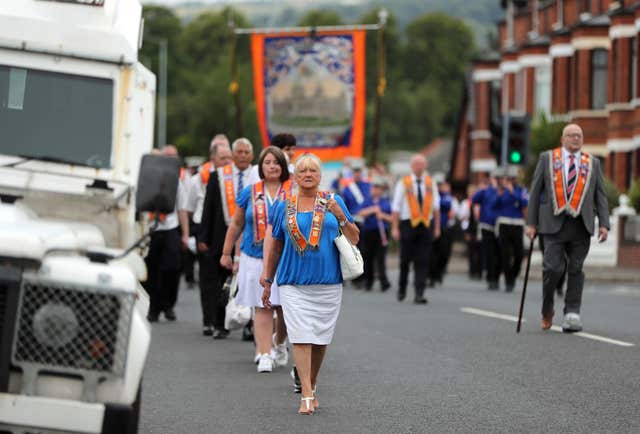All you need to know about Twelfth of July
Here is an overview of what the event is all about.

As Orange lodges and loyalist bands take to the streets of Northern Ireland to mark the Twelfth of July here is an overview of what the event is all about.
– What is the Twelfth?
It is the main date of the Protestant loyal order parading season, commemorating the victory of Protestant King William of Orange over Catholic King James II at the Battle of the Boyne, north of Dublin, in 1690 – a triumph that secured a Protestant line of succession to the British Crown. The Orange Order, which was founded in 1795, continues to champion William’s legacy by espousing loyalty to the Crown and the Reformed faith. While the Orange Order is strongest in Northern Ireland, it does have a presence in Great Britain, the Irish Republic and many former British colonies. Thousands of Orange lodge members parade through the summer months to celebrate William’s victory and other key dates in Protestant/unionist/loyalist culture. Those commemorations culminate on the Twelfth – the anniversary of the Boyne encounter.
– Why is it contentious?
Politics in Northern Ireland has long divided along traditional green and orange lines. Not surprisingly, the celebration of an historic battle fought on religious grounds is viewed very differently by the Protestant/unionist/loyalist and the Catholic/nationalist/republican communities in the region. Older generations would contend that the Twelfth was a non-contentious community event attended by Protestant and Catholic alike in the years before the Troubles. That changed markedly during the 30-year sectarian conflict that blighted Northern Ireland during the latter half of the 20th Century. The routes of certain Orange parades became a key friction point, often leading to widespread rioting and violence. While Orangemen insisted they had the right to parade on public roads following long-established traditional routes, residents in many nationalist neighbourhoods protested at what they characterised as displays of sectarian triumphalism passing through their areas.

– Are there still parading flashpoints?
Overf the years there have been many volatile flashpoints involving Orange lodges and nationalist residents. The most well-known include the Garvaghy Road/Drumcree dispute in Portadown, the Ormeau Road in south Belfast and the Ardoyne/Woodvale interface in north Belfast. A Government-appointed Parades Commission was established to adjudicate on contentious marches, with its decisions often the source of major controversy. While tensions around Drumcree and the Ormeau Road largely dissipated as the peace process developed, the Ardoyne stand-off remained an annual source of intense community discord until relatively recently. A locally negotiated deal brought a measure of resolution to that impasse in 2016, resulting in a largely incident-free Twelfth last year.
– So are the parades now sorted?
No. Not by a long way. The agreement at the Ardoyne was essentially a temporary truce pending a broader resolution being found. Stormont leaders have previously agreed to eventually take on the responsibility for parading issues from the Government, potentially replacing the Parades Commission with a new model. That plan was subsequently consumed by the wider political fallout at Stormont and is now well and truly on ice amid the ongoing absence of powersharing. A Stormont-established working
group set up to examine ways to deal with the thorny issues of flags, identity, culture and tradition has also yet to report and, even when it does, a lack of devolved government means there is little prospect of any recommendations being implemented in the short term.
– And what about bonfires?
Tradition sees huge bonfires lit in loyalist neighbourhoods across Northern Ireland on the night of July 11 as a way of ushering in the Twelfth. Most Eleventh Night fires pass off without incident, with organisers promoting them as family-friendly community celebrations, but a number have become the source of controversy in recent years. The disputes are of a different nature to those over parading, as they tend not to involve significant interaction with the nationalist community. The problems are
more centred on safety concerns within loyalist communities over the prospect of the towering pyres causing damage to homes and businesses. Bonfire builders, most of whom are youths or young adults, have found themselves at loggerheads with the statutory authorities and older members of their own communities. Police believe loyalist paramilitary elements also exert a malevolent influence in resisting efforts to relocate bonfires and restrict their size. For their part, the bonfire builders portray efforts to curtail the tradition as a veiled attack on their culture. Disorder broke out in Belfast on Wednesday night after the authorities moved in to remove material from two east Belfast bonfires constructed close to properties.





